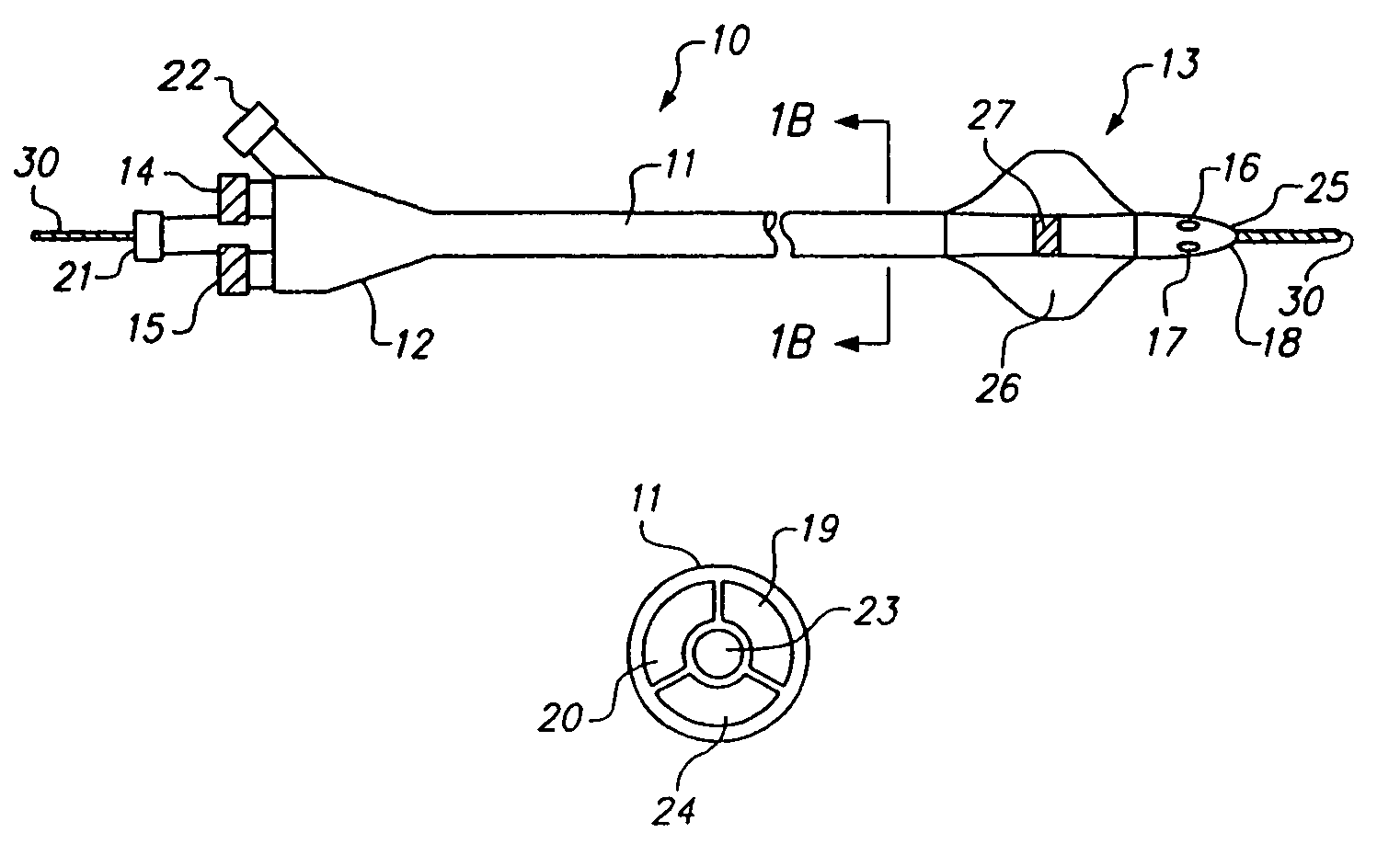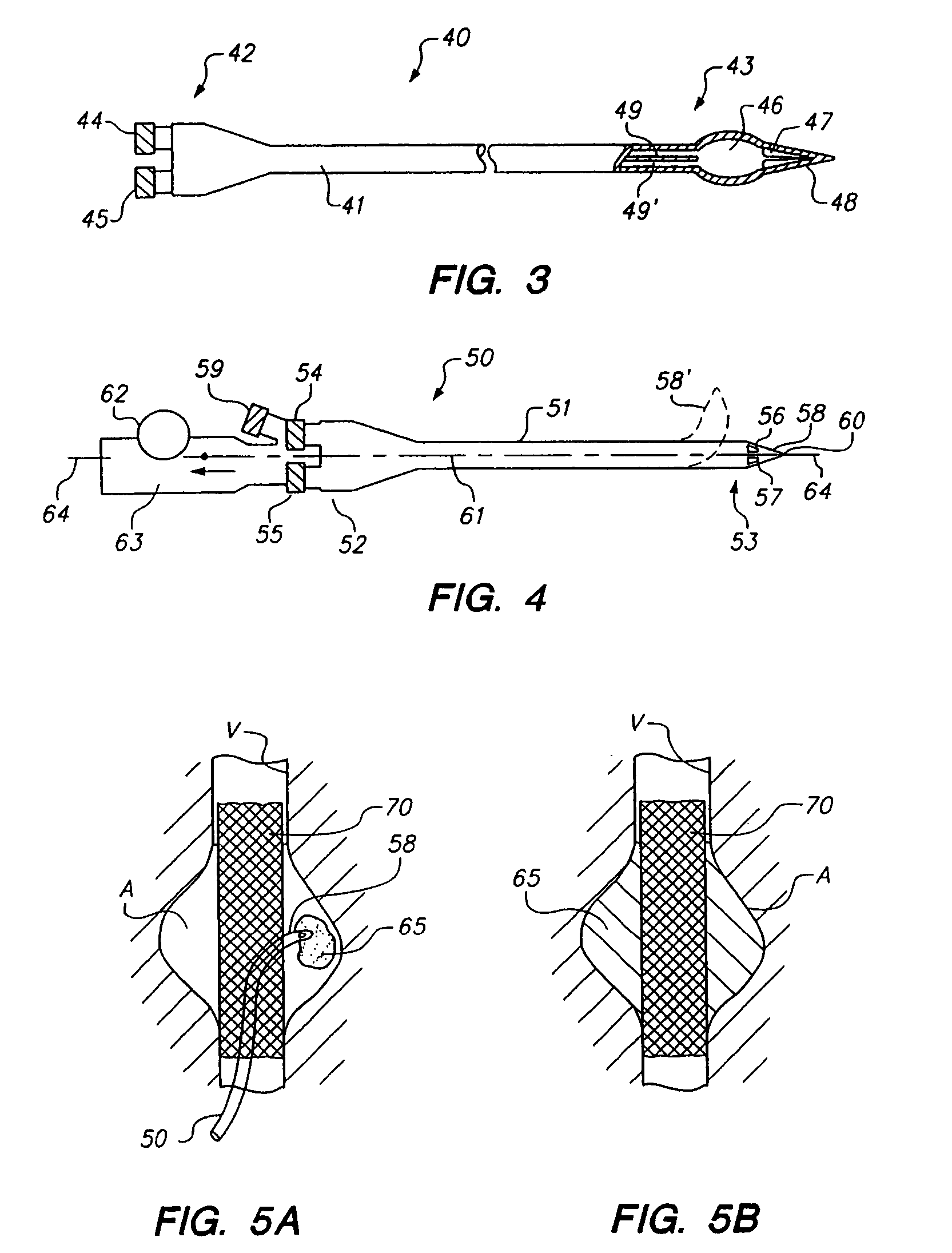Methods and apparatus for intraluminal deposition of hydrogels
a technology of hydrogels and hydrogels, which is applied in the direction of catheters, blood vessels, pharmaceutical product forms, etc., can solve the problems of engendering a variety of symptoms and limited utility of the devices described in the foregoing referen
- Summary
- Abstract
- Description
- Claims
- Application Information
AI Technical Summary
Benefits of technology
Problems solved by technology
Method used
Image
Examples
example 1
Preparation of a Metered Liquid Embolic
[0073]Previously known treatments for embolization all basically rely on blood flow in one form or another to either react to the material or to carry it downstream to a geometric constraint, such as a tapered portion of a vessel. A drawback of this approach, however, is that it is difficult to form a short site-specific occlusive plug.
[0074]Numerous instances where it is desirable to form a discrete “plug” to block a specific region of a vessel or a specific side-branch, for example, to treat an arterio-venous fistula (AVF) or patent ductus arteriosus (PDA). A desirable configuration would have the ability to deploy a plug in a controlled manner even in the presence of blood flow to cause embolization of the vascular defect, but low risk of accidental embolization of other downstream structures. Physically, such materials could be delivered via a screw-driven syringe handle that allows the two materials not only to be delivered equally, but al...
example 2
Preparation of a Diffusely Polymerizing Liquid Embolic
[0080]Occasionally a need arises for a more diffuse, deeper-reaching liquid embolic that is capable of flowing for some distance within the vasculature. The system described in this example 2 allows deep introduction of liquid embolic materials before curing and may be especially useful in treating hypervascular tumors (among other such diffuse vascular diseases, including arterio venous malformations), where it is necessary to infuse the materials as deep as possible into the tumor vasculature, thereby embolizing all of collateral and side-branches of the effected vasculature.
[0081]In this example 2, a combination of slower polymerization and lower material viscosities is provided, consisting of two PEG di-acrylate (20% 3.35 da) solutions in water with 3000 ppm hydrogen peroxide and 2% Ferrous gluconate as solutions A and B, respectively, with a 30% metrizamide concentration in each solution as a radiopacifying agent. The time f...
example 3
Preparation of a Bio-Resorbable Liquid Embolic
[0084]In many instances, such as arterio-venous malformations (“AVM”) or aneurysm, permanent occlusion of the defect is required. However, in other situations, permanent embolization may not be desirable. This may occur, for example, if one needs to re-visit a partially occluded tumor bed for further therapy. Previously known treatment modalities for hyper-vascular tumor embolization, with such materials as cyanoacrylate materials and small particle PVA, form a permanent “implant” that is either a hard polymeric branched implant or a plurality of small particles inhibiting flow by hitting a geometric restraint such as a tapered vessel diameter.
[0085]Because it may be necessary, however, to re-access the vessels of the tumor after they have been embolized, in case small collaterals have formed or side-branches had not been adequately embolized. With the previously known treatment modalities, it would be virtually impossible to re-canalize...
PUM
 Login to View More
Login to View More Abstract
Description
Claims
Application Information
 Login to View More
Login to View More - R&D
- Intellectual Property
- Life Sciences
- Materials
- Tech Scout
- Unparalleled Data Quality
- Higher Quality Content
- 60% Fewer Hallucinations
Browse by: Latest US Patents, China's latest patents, Technical Efficacy Thesaurus, Application Domain, Technology Topic, Popular Technical Reports.
© 2025 PatSnap. All rights reserved.Legal|Privacy policy|Modern Slavery Act Transparency Statement|Sitemap|About US| Contact US: help@patsnap.com



